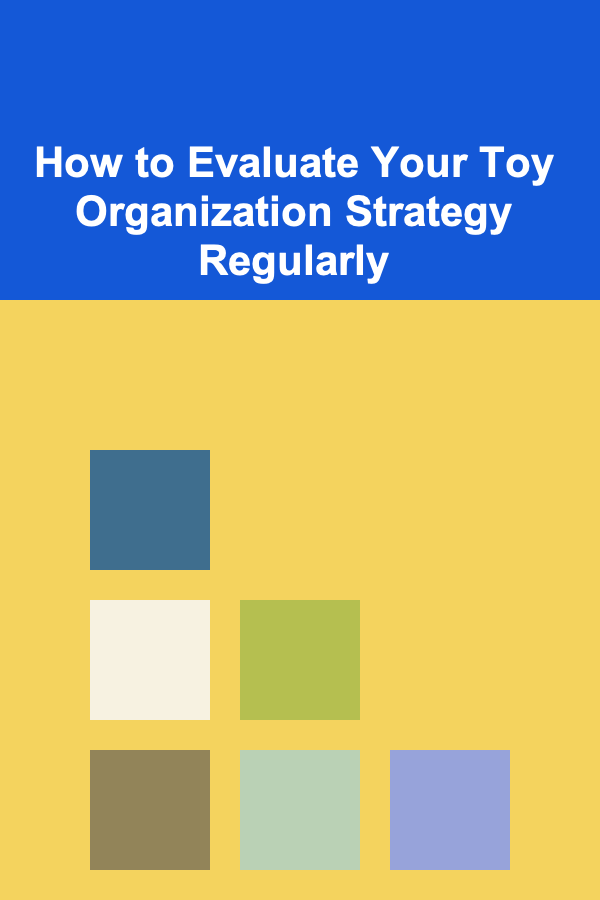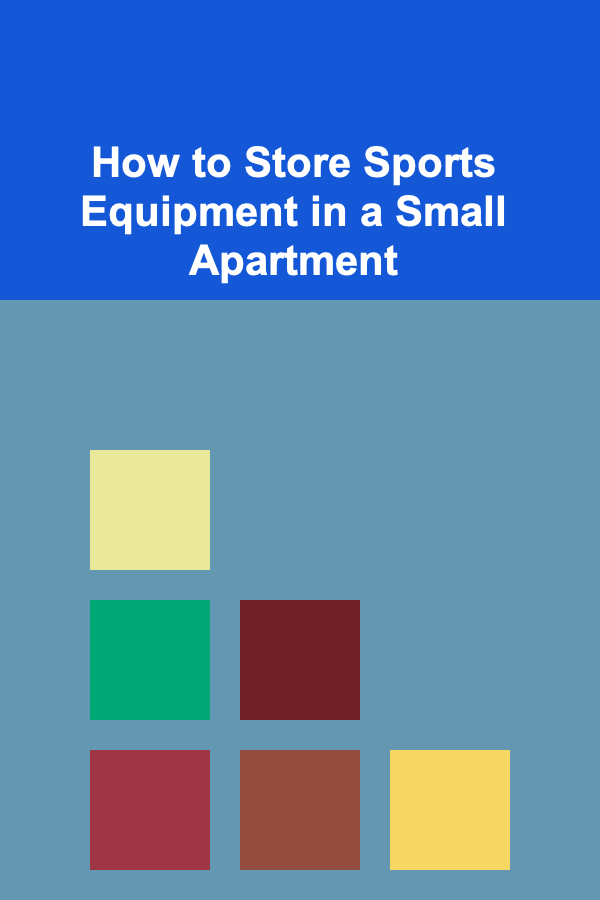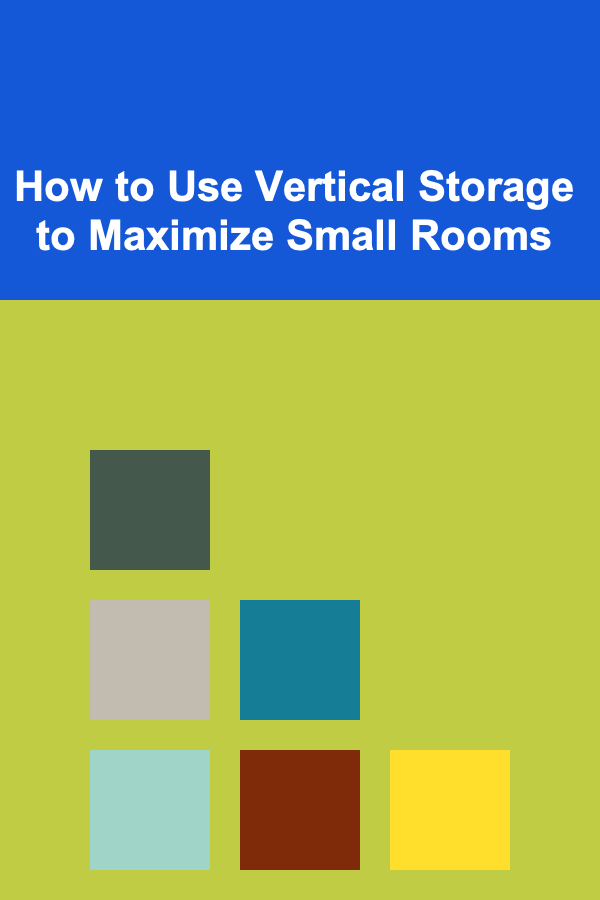
How to Evaluate Your Toy Organization Strategy Regularly
ebook include PDF & Audio bundle (Micro Guide)
$12.99$8.99
Limited Time Offer! Order within the next:

Effective toy organization is crucial for maintaining a tidy living environment, ensuring safety, and promoting a sense of responsibility in children. However, even the best organization strategies can become ineffective over time due to changing interests, new toy acquisitions, and evolving family dynamics. Regular evaluation of your toy organization strategy is essential to ensure it continues to meet the needs of both children and caregivers. This article will explore methods for evaluating your toy organization strategy, the benefits of regular assessments, and practical steps to improve your approach.
Understanding the Importance of Toy Organization
1.1 The Need for Organization
The accumulation of toys can quickly lead to clutter, making spaces less functional and enjoyable. A disorganized play area can hinder children's ability to engage creatively and safely with their toys. Effective toy organization involves not only arranging toys neatly but also ensuring they are easily accessible and categorized in a way that reflects the users' needs.
1.2 Benefits of Regular Evaluation
Regular evaluations of your toy organization strategy offer several advantages:
- Adaptability: As children grow and their interests change, so too should the organization strategy. Regular evaluations help adapt the system to these changes.
- Safety: Evaluating toy condition and organization helps identify broken or unsafe items, ensuring a safe play environment.
- Encouragement of Responsibility: Involving children in the evaluation process teaches them about organization and responsibility for their belongings.
- Maximized Space: Regular assessments can uncover underutilized areas and improve overall space management.
Signs That It's Time to Evaluate Your Strategy
2.1 Clutter Accumulation
If you notice an increase in clutter despite efforts to maintain organization, it may be time to reassess your strategy. Toys may be piling up in unexpected areas, indicating that the current system is no longer effective.
2.2 Difficulty Finding Items
If children (or adults) frequently struggle to find specific toys, it's a sign that the organization system needs an overhaul. An efficient system should allow for quick retrieval of items without frustration.
2.3 Changes in Interests
As children grow, their interests evolve. If toys that were once popular are now rarely used, it may be time to consider removing these items from circulation or relocating them.
2.4 Safety Concerns
If you observe broken toys or items with missing pieces, it's critical to evaluate the safety of the play environment. Regular evaluations can help identify hazards and ensure a safe space for children.
Methods for Evaluating Your Toy Organization Strategy
3.1 Self-Assessment
Conducting a self-assessment is a straightforward and effective way to evaluate your toy organization strategy. Here's how to do it:
3.1.1 Set Criteria for Evaluation
Create a list of criteria that your toy organization system should meet. Consider factors such as:
- Accessibility: Are toys easy to reach and put away?
- Visibility: Can children see their toys without difficulty?
- Safety: Are there any broken or hazardous items?
- Flexibility: Does the system adapt to changing interests?
3.1.2 Conduct Observations
Spend some time observing how children interact with their toys. Take note of:
- Which toys are frequently used and which are ignored.
- How children navigate the play area.
- Any frustrations they express regarding finding or using toys.
3.1.3 Collect Feedback
Engage children in a conversation about their toys. Ask questions such as:
- What are your favorite toys and why?
- Are there any toys you find difficult to use or access?
- Would you like to change anything about how your toys are organized?
3.2 Family Meetings
Involving the whole family in evaluating toy organization can foster teamwork and ensure everyone's perspectives are considered. Here's how to conduct a productive family meeting:
3.2.1 Schedule Regular Meetings
Set a recurring date for family meetings focused on toy organization. This could be monthly or quarterly, depending on the amount of toy turnover.
3.2.2 Create an Agenda
Prepare an agenda to keep the meeting focused. Topics could include:
- Review of toy usage since the last meeting.
- Discussion of any safety concerns.
- Ideas for improving organization.
3.2.3 Encourage Participation
Make sure everyone has a chance to voice their opinions. This not only improves the evaluation process but also helps children feel more invested in their toy organization.
3.3 Inventory Check
Performing a toy inventory check can provide valuable insights into your organization strategy's effectiveness. Here's how to conduct an inventory check:
3.3.1 Gather Supplies
Collect materials needed for the inventory check, such as:
- Notebooks or digital devices for recording findings.
- Storage bins for sorting toys.
- Labels and markers for organization.
3.3.2 Sort and Categorize
Take all toys out of storage and sort them into categories. Common categories might include:
- Age group
- Type (e.g., educational, outdoor, creative)
- Condition (broken, in good shape)
3.3.3 Evaluate Each Category
Assess each category based on predetermined criteria. Look for:
- Usage frequency: Which toys are most and least used?
- Condition: Are there any toys that need repair or replacement?
- Relevance: Are there toys that no longer fit your child's interests?
3.4 Utilize Technology
Technology can be a powerful ally in evaluating your toy organization strategy. Here are some tools to consider:
3.4.1 Inventory Management Apps
Mobile apps designed for inventory management can streamline the evaluation process. Features to look for include:
- Barcode scanning for easy entry of toys.
- Categorization options for sorting.
- Reminders for regular checks.
3.4.2 Digital Organization Tools
Consider using digital tools like Google Sheets or Trello to track toy inventory and organization status. Set up columns for:
- Toy name
- Category
- Condition
- Notes (e.g., where it's stored)
3.5 Visual Assessments
Sometimes, a visual assessment can be the most revealing method. Use the following approach:
3.5.1 Take Photos
Before and after organizing sessions, take photos of the play areas. This visual documentation can highlight changes over time and reveal patterns in toy usage.
3.5.2 Create a Visual Map
Draw a map of the play area, marking where each category of toys is stored. This can help identify areas that might need improvement or reassessment.
Implementing Changes Based on Evaluation
Once you have conducted an evaluation, it's time to implement changes. Here are some steps to consider:
4.1 Decluttering
One of the most impactful changes you might make is decluttering. Here's how to do it effectively:
4.1.1 Set Clear Guidelines
Establish criteria for what stays and what goes. For example:
- If a toy hasn't been used in six months, consider donating it.
- Broken toys should be repaired or discarded.
4.1.2 Involve Children
Involve children in the decluttering process. This not only teaches them about decision-making but also allows them to understand the importance of keeping only what is necessary.
4.2 Redesigning Storage Solutions
After evaluating your toy organization strategy, you may find that your storage solutions need an upgrade. Here are some ideas:
4.2.1 Utilize Vertical Space
Consider shelving units or wall-mounted storage to maximize vertical space. This can help keep the floor clear and make storage more accessible.
4.2.2 Invest in Bins and Labels
Investing in clear storage bins and labels can enhance organization. Ensure that labels are visible and easy to read, allowing children to find and return items with ease.
4.2.3 Create Zones
Designate specific zones for different types of play. For instance, have an arts and crafts zone, a reading nook, and an outdoor play area. This can help children associate specific spaces with certain activities.
4.3 Establishing a Maintenance Routine
Creating a maintenance routine is essential for sustaining your toy organization efforts. Here are some tips:
4.3.1 Regular Check-ins
Schedule regular check-ins to assess the state of the toy organization. These can be brief sessions to ensure everything is in order.
4.3.2 Teach Children About Maintenance
Involve children in maintaining their play areas. Teach them the importance of putting toys back in their designated spots after use and conducting mini-checks every week.
4.3.3 Keep It Fun
Gamify the maintenance process. For example, set a timer and see how many toys children can put away in five minutes. Reward them for their efforts to encourage continued participation.
4.4 Adapting to Changes
As children grow and their interests evolve, your toy organization strategy must adapt accordingly. Here are ways to remain flexible:
4.4.1 Stay Updated on Trends
Keep an eye on trends in children's toys and preferences. This can help you anticipate changes in interests and adapt your organization strategy proactively.
4.4.2 Encourage Exploration
Allow children to explore new toys and activities, even if it means temporarily adjusting your organization strategy to accommodate new interests.
Monitoring Progress Over Time
Evaluating your toy organization strategy should be an ongoing process. Here are some methods to monitor progress:
5.1 Set Goals
Establish specific goals for your toy organization strategy. These could include:
- Reducing clutter by a certain percentage.
- Ensuring all toys are in good condition.
- Improving accessibility for all family members.
5.2 Track Changes
Keep a record of changes made during each evaluation cycle. This could involve:
- Noting which toys were donated or discarded.
- Documenting new storage solutions implemented.
- Recording feedback from family members.
5.3 Celebrate Successes
Recognize and celebrate successes along the way. Whether it's a tidier play area or improved engagement from children, acknowledging achievements can motivate continued efforts.
Conclusion
Regularly evaluating your toy organization strategy is essential for maintaining a functional and enjoyable play environment. By employing various evaluation methods, involving family members, and implementing changes based on assessments, you can create a dynamic organization system that adapts to the needs of your family.
From self-assessments to utilizing technology, the tools and techniques discussed in this article will empower you to maintain an organized space conducive to creativity and play. Remember that organization is an ongoing process; staying proactive and adaptable will help you create a positive experience for both children and caregivers alike. Embrace the journey of discovery and learning that comes from effective toy organization, and enjoy the benefits of a well-structured play environment.
Reading More From Our Other Websites
- [Home Party Planning 101] How to Identify the Best Party Planners for Your Home Celebration
- [Home Budget Decorating 101] How to Create a Stunning DIY Macrame Wall Hanging on a Shoestring Budget
- [Beachcombing Tip 101] Treasure on the Tide: 10 Unexpected Gems Found While Beachcombing
- [Toy Making Tip 101] Weekend Workshop: Building Perfect Playthings with Kids
- [Personal Care Tips 101] How to Use Conditioner for a Relaxing and Pampering Hair Care Routine
- [Home Soundproofing 101] How to Achieve Maximum Soundproofing in a Small Apartment
- [Home Party Planning 101] How to Create a Fun and Engaging Themed Photo Booth for Your Party
- [Home Staging 101] How to Stage a Small Home: Maximizing Space and Style
- [Personal Care Tips 101] How to Practice Mindfulness in Your Daily Life
- [Personal Care Tips 101] How to Incorporate Natural Personal Care Products into Your Daily Routine

How to Display Cookbooks in a Stylish Way
Read More
How to Make Money Online as a Proofreader: 10 Actionable Ideas
Read More
How to Profit from Deep Learning as a Freelancer
Read More
How to Store Sports Equipment in a Small Apartment
Read More
How to Use Vertical Storage to Maximize Small Rooms
Read More
How to Use Mindfulness for Healing Past Trauma
Read MoreOther Products

How to Display Cookbooks in a Stylish Way
Read More
How to Make Money Online as a Proofreader: 10 Actionable Ideas
Read More
How to Profit from Deep Learning as a Freelancer
Read More
How to Store Sports Equipment in a Small Apartment
Read More
How to Use Vertical Storage to Maximize Small Rooms
Read More